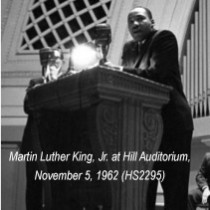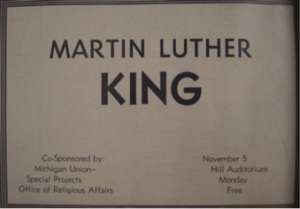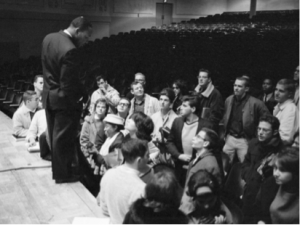News Stories

Live as Brothers, or Die as Fools
MLK came to Ann Arbor to speak at U-M just once, in 1962. Rarely seen documents and photos from the Bentley Historical Library shed light on the leader’s legendary visit.
by Brian A. Williams
“The American dream is as yet unfulfilled,” said Martin Luther King, Jr., speaking in the University of Michigan’s Hill Auditorium on November 5, 1962. King’s speech was one of two he gave that day in Ann Arbor, Michigan, to capacity crowds in Hill Auditorium. In addition to presenting two public lectures, King also participated in a special invitation discussion at the Michigan Union. The appearance by King on the eve of the 1962 mid-term elections was part of the Annual Religious Lecture Series sponsored by the U-M Office of Religious Affairs, other speakers in the fall series were University of Chicago theology professor Preston Roberts and philosophy professor Paul Schilipp of Northwestern.
Getting King to Campus
Religious Affairs staff reached out to other groups on campus to cosponsor King’s visit and secured sponsorship from the Michigan Union’s Special Projects Committee. The Union’s Special Projects Committee was in the midst of sponsoring a lecture series on the theme of civil liberties and was eager to include King. Six-time Socialist party candidate for U.S. President Norman Thomas was the first speaker in the civil liberties series. Thomas appeared on October 18 and addressed an overflow crowd in the Union Ballroom. Outlining challenges to civil liberties and presaging King’s appearance on campus, Thomas told the crowd that “the dominant white race should be thankful that the avant garde of the Negro people have taken the non-violent path to secure their rights.” Organizers of the lecture series expressed confidence that “the second speaker on our program will generate even more interest than has Dr. Thomas.”
They went on to promote King’s upcoming November 5 appearance, describing him as an “articulate and controversial speaker” active in the push for integration in the South.

Flier for King’s appearance, created by U-M’s Special Projects Office (U-M Office of Ethics and Religion, Box 11) (BL 018270)
Staff in the Special Projects Office produced a mimeographed flier along with an explanatory note to promote King’s two lectures. In the mailing to residential housing staff dated October 26, organizers stressed that “no student at the University of Michigan should miss hearing Martin Luther King.” The simple mimeographed flier advertising the free appearance by King noted that at 4:00 p.m. he would speak on “Moral Issues in Discrimination” followed by an 8:00 p.m. speech on “The Future of Integration.”
Support from Campus Organizations
In addition to highlighting the two main sponsors of the lectures, the bottom of the flier included the notation that the appearance was in association with three other organizations: Voice, Women’s International League, and Challenge.
All three associated organizations were sympathetic to the causes espoused by King. The Voice campus political party was established in 1960 by Tom Hayden.
It soon became a core chapter of the newly founded Students for a Democratic Society. A key component of the Voice platform was eliminating inequality, especially economic, social, and racial inequality. On civil rights, Voice supported the Kennedy Administration’s civil rights bill but felt it did not go far enough. Voice’s platform gave full support for the Student Nonviolent Coordinating Committee (SNCC) in the South while also recognizing that race issues in the “North are subtler but no less vicious than in the South.”
The second organization listed was the Ann Arbor-Ypsilanti branch of the Women’s International League for Peace and Freedom. In its October 30 newsletter, the Women’s International League expressed relief following the just-averted Cuban Missile Crisis, noting that the crisis had attracted wide attention for peace groups such as theirs. The group was also actively planning their November 17 conference on “Technical Problems in the Adjustment to Peace” presented in conjunction with the U-M Center for Conflict Resolution. Among the upcoming events listed in the newsletter was the November 5 appearance by King with the notation “WIL is a contributing organization to enable him to speak in Ann Arbor.”
Challenge, the third associated group, was a student organization established on campus in 1960 to encourage involvement in crucial problems by bringing prominent national figures to campus to promote discussion and action. The Challenge program began at Yale and spread to other campuses across the nation.
Student organizers at U-M solicited faculty “sponsors” who would agree to have their names listed on a brochure describing the program. The subsequent list of 23 Michigan faculty sponsors appearing in the brochure included several prominent faculty members: Robert C. Angell, Kenneth Boulding, Angus Campbell, William Haber, E. Lowell Kelly, Theodore Newcomb, and Allan F. Smith.
Finalizing the Minister’s Schedule
The Invitation for King to visit campus came through Harold K. Duerksen, a program director with the Office of Religious Affairs. Correspondence in the King archives at Boston University indicate that Duerksen first contacted King in 1961. Given King’s busy schedule as a minister, president of the Southern Christian Leadership Conference, and his emerging national role as a spokesman for integration and civil rights, it was difficult to find a suitable date. Once the details of the date and sponsorship were nailed down, planning began in earnest to maximize King’s time on campus. An invited luncheon for 50-60 people was planned for the Union’s Anderson Room. The tentative guest list for the luncheon included Special Events Program staff, Student Government Council officers, Union senior officers, U-M President Harlan Hatcher, Vice Presidents Roger Heyns, James Lewis, and Marvin Niehuss. Other individuals on the tentative guest list included Tom Hayden and Al Haber, key members of Students for a Democratic Society, as well as members of the other sponsoring organizations.
Newspaper Coverage, for Better or Worse

The Michigan Daily’s November 4, 1962 ad for MLK’s appearance did not list the times for his lectures.
In addition to the flier publicizing the event, a six-inch by eight-inch advertisement in bold capital letters appeared in the October 28, 1962, issue of The Michigan Daily announcing King’s public lectures. The appearance was also listed in The Michigan Daily calendar of events in the days leading up to King’s visit. The local town paper, the Ann Arbor News, ran a regular feature “What’s Doing At University” and listed both of King’s lectures in the November 3 column.
A large advertisement covering nearly a third of a page promoting King’s appearance ran on the back page of The Michigan Daily the day before King’s visit, but interestingly did not list the times of the lectures.
King spoke on a cool fall day. The temperatures started off in the upper 40s and cooled to near 30 degrees in the evening. No recordings of King’s lectures are known to exist, and newspaper coverage is scant at best. The only local newspaper coverage appears in the November 6 issue of the U-M student paper. While the Ann Arbor News published calendar notices about the lectures, the paper did not publish a story on King’s appearance. Instead, the town paper published a story about the lecture on civil liberties given by John de J. Pemberton, Jr., executive director of the American Civil Liberties Union, who spoke at 3:00 p.m. in the Undergraduate Library on the same day.
Students Marjorie Brahms and Martha MacNeal reported on King’s lecture for The Michigan Daily. Chronicling King’s talk, the reporters noted that he framed his discussion by stating that every man is “heir to a legacy of dignity and worthiness,” and that man’s essential rights do not originate from the state, but rather are established by God. King touched upon integration and the immoral nature of racial discrimination. He expanded on that theme pointing out that the American dream cannot be separated from the world dream of brotherhood.
King told the audience, “we must learn to live together as brothers or we will die together as fools.” He declared that the outmoded idea of superior and inferior races must be abolished.
Turning to racial segregation in the U.S., King conceded that laws may not change one’s heart, but legislation can regulate actions. King called for the federal government to step up, imploring President John F. Kennedy to sign an executive order declaring segregation unconstitutional. The failures of the legislative branch were singled out as was the role of organized religion.
King underscored “the shameful fact that the church is still the most segregated institution in America today.”
A Responsibility to Participate

Martin Luther King, Jr. at Hill Auditorium. Harold K. Duerksen in background (1963 Michiganensian yearbook)
In the portion of his lectures directed specifically to students, King urged them to take action and join the growing student movement. Apparently he had been briefed about the recent state of the university address given by President Hatcher where Hatcher had encouraged students to limit their involvement in student movements and to restrict their activities to the campus. King sharply disagreed, telling students that they “have a responsibility to participate in the movement.” He went on to tell them that to him, education meant “being true to studies yet devoting oneself to a significant cause like integration.”
A series of photo negatives contained in the archived records of the U-M Media Resources Center provides evidence of King’s appearance in Hill Auditorium and some smaller gatherings with King that day. The images also show the aftermath of the lectures with a small group of students and community members clustered around the edge of the stage while King fielded questions. According to Dr. Larry Brilliant’s 2011 Peter M. Wege Lecture delivered at U-M’s Rackham Auditorium, he was among the students visiting with King afterward.
Brilliant credits King with inspiring him to his life’s work, which included eradicating the world of smallpox and working for global sustainability.
Brilliant also referenced witnessing King’s talk in his 2013 commencement address at the Harvard School of Public Health, when he spoke of being a “completely clueless sophomore” as he went to hear King but coming away inspired that it “was our destiny to become activists.”
Never to Return to Campus
Martin Luther King, Jr. would be invited back to Ann Arbor but would never again set foot on campus. By 1963, the March on Washington and King’s “I Have a Dream” speech had elevated King’s status as a national figure. In a 1964 letter to Eugene Ransom, a religious counselor at U-M, King declined another invitation to speak in Ann Arbor, citing a policy of not accepting more than one external Sunday engagement away from his church each month and indicating that he was already fully booked for the upcoming academic year. Later that year King would win the Nobel Prize, cementing his status as a world figure.
The campus and community overflowed Hill Auditorium once more to recognize King on April 5, 1968. Unfortunately, it was a grieving community remembering the life and legacy of the slain civil rights leader. Students filled the seats and aisles in Hill Auditorium, while hundreds more gathered on the terrace outside and listened to the memorial service broadcast over speakers. Among the speakers were Vice President Allan F. Smith, Dean William Haber, Professor Albert Wheeler, Reverend Emmett Green of Ann Arbor’s Second Baptist Church, and Samuel Jones, a student. Many who were there to hear King on that memorable November day in 1962 were again on hand to eulogize him as a testament to his impact on the mourning nation.
Sources
Details of the visit by Martin Luther King, Jr. to U-M in November 1962 came from several sources in the Bentley Historical Library, including records of the U-M Office of Ethics and Religion (particularly program files, 1958-1963, and the 1962-63 annual report of the Office of Religious Affairs), Women’s International League for Peace and Freedom, Ann Arbor-Ypsilanti Branch records, U-M Media Resources Center (negatives of King’s visit), Vertical File (particularly Students for a Democratic Society; Voice), the papers of Kenneth Boulding, and the Eugene Ransom and Jeanne Bailey Ransom papers. Coverage of the presentation by Norman Thomas came from The Michigan Daily as did coverage of King’s appearance and related advertisements. The Ann Arbor News (held elsewhere on the U-M campus) was also consulted.


